Revoice Pro Sessions
When Revoice Pro starts, it opens an empty three-track Session window as shown below. However, Revoice Pro supports multiple windows which can contain either different Sessions or additional independent views of the same Session.
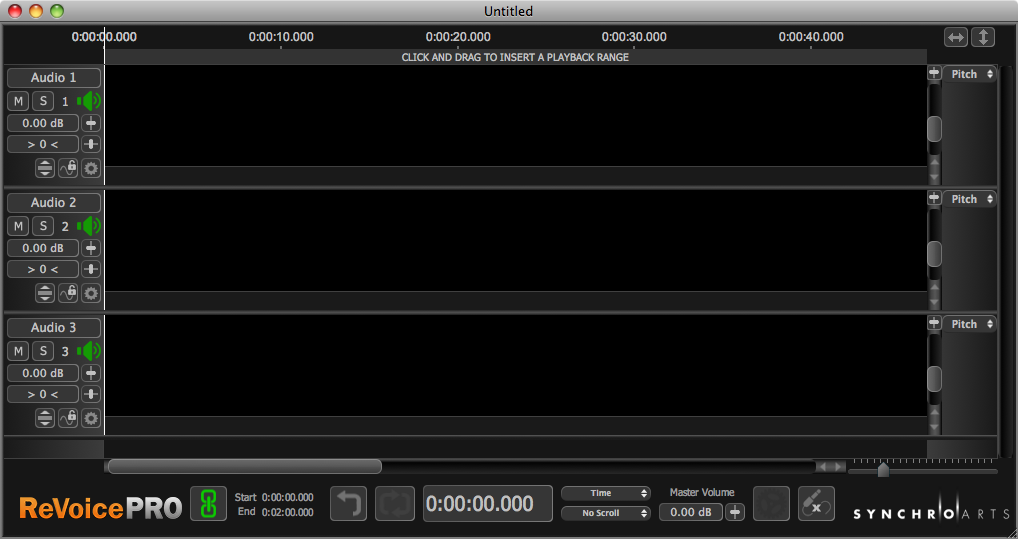
In addition, Revoice Pro can contain an unlimited number of Tracks. But, unlike traditional audio editors, each Revoice Pro Track contains a large area for displaying the audio and optionally energy, pitch and loudness, and a smaller area under the main area that holds the Process Control Blocks.
The multi-track view can be switched to view a full-height single track by using Single/Multi Track display control in the Track Control Panel.
Using Sessions
Revoice Pro Sessions contain, display and retain all the audio and process control settings.
The session name is shown at the top of the Revoice Pro Window. The name remains "Untitled" until the session is saved with a name.
- Sessions are saved with a .rvp extension.
- Multiple sessions can be open simultaneously.
- Like other audio editing systems, you can
save and load Revoice Pro Sessions using the “File” menu shown below for Mac (left) and Windows (right) or the Quick Key Shortcuts following each command.
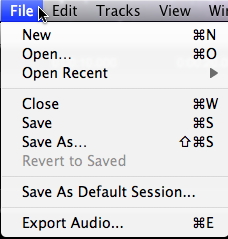
The menu actions are:- New - Create a new Session
- Open and Open Recent – Opens previously saved Sessions.
- Close – Closes current Session
- Save – Saves current Session
- Save As – Saves as Session with new user-assigned name
- Revert to Saved - Restores the previously saved Session version (losing all unsaved edits)
- Save As Default Session ... Saves the track layout, names and settings of the current Session (including audio, if any) to be opened when next select "New". [Click here for more details]
- Export Audio - Opens a window for selecting audio to write to files. Click here for details.
Note: These menu options will vary depending on the version of OS X that you are using.
- If you save a session that has temporary audio files associated with it, such as those generated by plug-ins using Revoice Pro, you will be asked for a location to save the associated audio. If you have loaded audio manually into Revoice Pro, it knows where this is located and so will not ask you for a location to save it.
- Using the “Window” top menu item, You can also open multiple windows on the same Session (for example if you want to examine two time-separated areas of the tracks at the same time. )
- For Mac Users on OS X 10.7 and later Revoice Pro will work with Time Machine (see image below) to periodically save your sessions while you are editing. You can then enter Time Machine while Revoice Pro is displayed and view and restore previous versions of your session.
- From version 3.1 there is an Auto Save option that will determine whether Revoice Pro saves session files automatically (in previous versions it always did this). This option is turned on with a check box in the Preferences control panel.
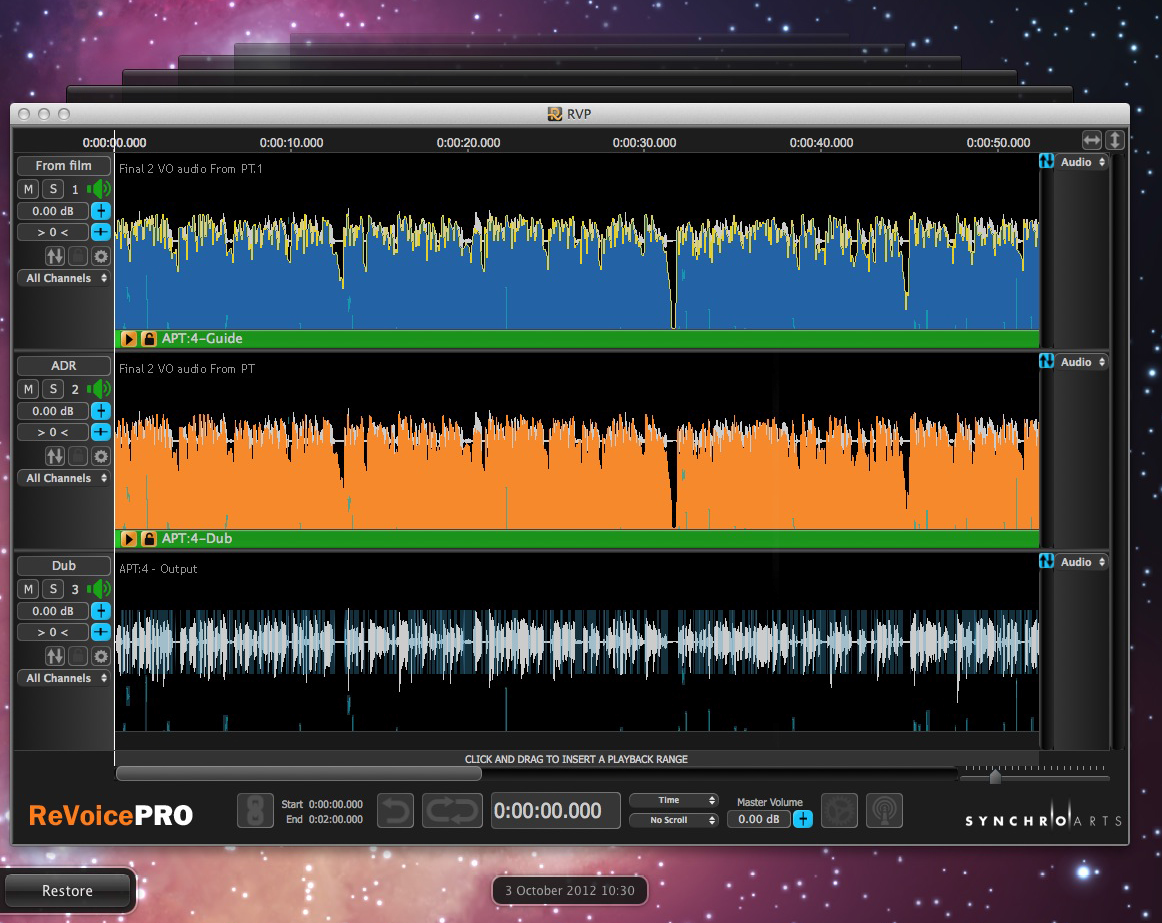
Track Operations
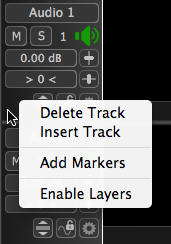 A menu of some Track-based functions can be accessed by RIGHT CLICKing in an "empty" area of the Track Control panel as shown at right. The selectable items includes Insert Track and Delete Track, which are self explanatory.
A menu of some Track-based functions can be accessed by RIGHT CLICKing in an "empty" area of the Track Control panel as shown at right. The selectable items includes Insert Track and Delete Track, which are self explanatory.- The last menu items, Add Markers and Enable Layers, provide further useful functionality and are discussed in the section on Advanced Features.
- Tracks can be re-arranged in the Session window by holding down the LEFT Mouse button in an empty area in the Track Control Panel and, with the Hand icon, dragging the Track's "ghost" up or down and dropping it in another "destination" Track Control Panel.
- If the "ghost" is dropped in the top half of the destination track's window - the dragged track will be placed above the destination track.
- If the "ghost" is dropped in the bottom half of the destination track's window - the dragged track will be placed below the destination track.
- Tracks can be inserted with the Tracks menu Add Tracks... command: CMD SHIFT N (Mac) / Ctrl SHIFT N (Windows). The number of new tracks and their base name can be entered in the window subsequently displayed. Each consecutive track so created will have an incremented number in brackets after the name, e.g. Audio, Audio(2), Audio(3), ... Audio(n).
- Tracks can be duplicated by pressing ALT key (Mac) / Ctrl key (Windows) and LEFT CLICK and hold down mouse button and dragging a Track Control panel to another track. The dragged track control panel will be duplicated and an auto-incremented number will be added to the end of the current name, if the source track is labelled "Audio n" or "Output n" (where n is a number). (This only duplicates the basic track settings, such as level, pan, but not the content or processes.)
- Track heights can be resized by selecting anywhere on the thick horizontal separator line between tracks and when the up/down arrow icon appears, hold down a LEFT CLICK and drag the line up or down to increase or decrease the Track height.
If the SHIFT key is held down, ALL the track heights will be adjusted at the same time. - Tracks can be "Cleared" of all Audio and Processes by selecting Clear Tracks command in Tracks menu. The Tracks layout and Track Control Panels will be preserved. This command can be used to create Session Templates (Click here for information).
- A Full height view of a single Track in the muliti-track display can be displayed by pressing this button in the Track Control Panel

Pressing it again will restore the multi-track display. - To show only Tracks used by the selected Process, press the Z key. To show all the tracks, press X key.
- To toggle hiding the Displays of processes that are not selected, press the C key.

See tracks menu below for Mac (left) and Windows (right)
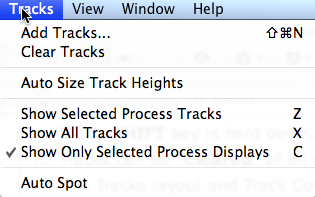
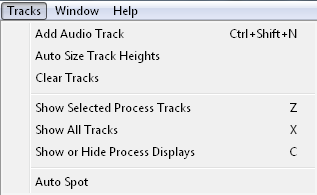
Multiple Windows of Same Session
An important feature to note is that Revoice Pro Sessions can have more than one window viewing the Session open at the same time.
This allows, for example, looking at the start of a Session in one window and the end of the same Session in another window and copying audio between the two windows or even using different windows to set inputs to the same Process.
Process Identification in Multi-track Sessions
Revoice Pro has a display in the view window's right hand border which shows what is currently editable in the tracks related to a selected Process or waveform. This is particularly useful as more tracks get added to a session, as in the image below.
The selected Guide and Dub Process Input blocks for (APT:1) are shown in light green and the Output of APT:1 is shown in darker green in the image above. But the selected process' information is also displayed in the Selected Item Display at the right of the image which identifies the selected tracks and editable items in the selected process. Even if the selected process scrolls horizontally out of the main window's time view, the item shown in this special area remain displayed. The drop down menus in this display can be used to make items editable and the display scalable.
If we then click on the Process Control Blocks for APT:4 or its output, then the Selected Item Display will switch to show that processes' details on the appropriate tracks.
Session Templates
If you find you repeatedly use the same track layouts in Revoice Pro Sessions, you can create an empty Session, insert and name the required tracks and then save the Session with a descriptive name such as "Lead with 2Harm and doubles" before loading any audio to serve as a "Template". Then, for future Sessions, you can open the Template Session, populate it with audio, and save it with a different name so you can use the empty Template again.
This saved Session will also contain any existing Track Control settings, including pan, solo, mute and volume controls.
if you use always want to start with a specific Session layout when you use the New Sessions menu item to create a new Session, you can optionally save a Session as a Default Session, as described next.
Default Sessions
If you are constantly creating Sessions with the same specific track names and track arrangements that remain roughly the same from Session to Session, you can save a great deal of time by creating a Default Session (without audio) that will open every time you use the File menu New command.
This session will contain not only the Track information, but Session information including Rewire offsets and timecodes.
To create a Default Session, we recommend the following steps:
- When you have a Session with Track names, orders of Tracks, pan, solo and volume controls that you want to reuse, if it contains audio, you can first remove all the audio and processes by using the Clear Tracks command in the Tracks menu.
- When the Tracks are cleared, then use the command Save as Default Session in the Revoice Pro File menu.
- If you want to delete the Default Session and return to the 3-Track "factory" Default Session (shown at the start of this chapter), the Default Template file is stored here and can simply be deleted manually:
~/Library/Application Support/SynchroArts/RevoicePro/SessionTemplate/Default.RPTemplate
Session file format
The session file format for Revoice Pro changed in version 3.1 and is no longer compatible with earlier versions. Version 3.1 will open older version session files, but older versions of the application will not open v3.1's session files.


